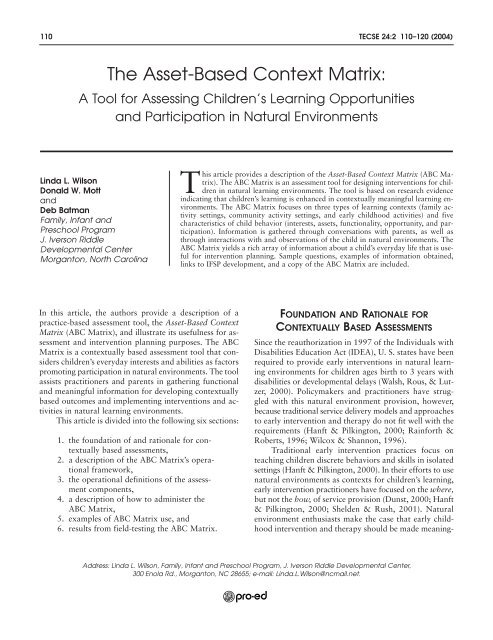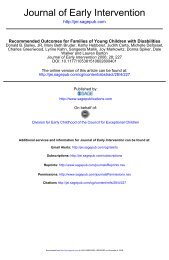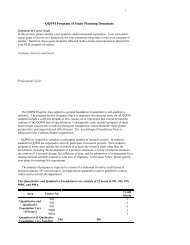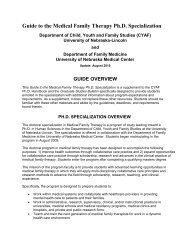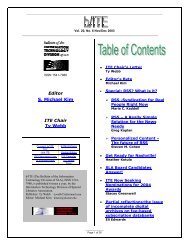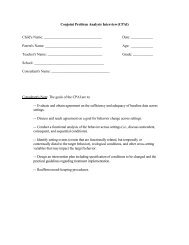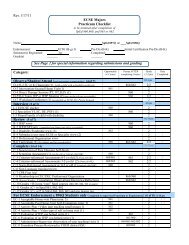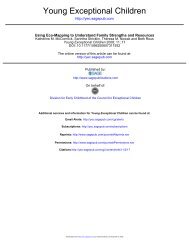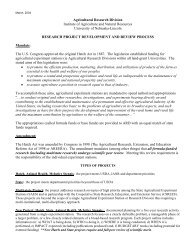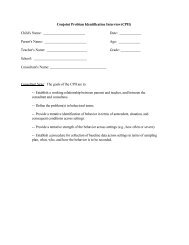The Asset-Based Context Matrix
The Asset-Based Context Matrix
The Asset-Based Context Matrix
Create successful ePaper yourself
Turn your PDF publications into a flip-book with our unique Google optimized e-Paper software.
110 TECSE 24:2 110–120 (2004)<br />
<strong>The</strong> <strong>Asset</strong>-<strong>Based</strong> <strong>Context</strong> <strong>Matrix</strong>:<br />
A Tool for Assessing Children’s Learning Opportunities<br />
and Participation in Natural Environments<br />
Linda L. Wilson<br />
Donald W. Mott<br />
and<br />
Deb Batman<br />
Family, Infant and<br />
Preschool Program<br />
J. Iverson Riddle<br />
Developmental Center<br />
Morganton, North Carolina<br />
This article provides a description of the <strong>Asset</strong>-<strong>Based</strong> <strong>Context</strong> <strong>Matrix</strong> (ABC <strong>Matrix</strong>).<br />
<strong>The</strong> ABC <strong>Matrix</strong> is an assessment tool for designing interventions for children<br />
in natural learning environments. <strong>The</strong> tool is based on research evidence<br />
indicating that children’s learning is enhanced in contextually meaningful learning environments.<br />
<strong>The</strong> ABC <strong>Matrix</strong> focuses on three types of learning contexts (family activity<br />
settings, community activity settings, and early childhood activities) and five<br />
characteristics of child behavior (interests, assets, functionality, opportunity, and participation).<br />
Information is gathered through conversations with parents, as well as<br />
through interactions with and observations of the child in natural environments. <strong>The</strong><br />
ABC <strong>Matrix</strong> yields a rich array of information about a child’s everyday life that is useful<br />
for intervention planning. Sample questions, examples of information obtained,<br />
links to IFSP development, and a copy of the ABC <strong>Matrix</strong> are included.<br />
In this article, the authors provide a description of a<br />
practice-based assessment tool, the <strong>Asset</strong>-<strong>Based</strong> <strong>Context</strong><br />
<strong>Matrix</strong> (ABC <strong>Matrix</strong>), and illustrate its usefulness for assessment<br />
and intervention planning purposes. <strong>The</strong> ABC<br />
<strong>Matrix</strong> is a contextually based assessment tool that considers<br />
children’s everyday interests and abilities as factors<br />
promoting participation in natural environments. <strong>The</strong> tool<br />
assists practitioners and parents in gathering functional<br />
and meaningful information for developing contextually<br />
based outcomes and implementing interventions and activities<br />
in natural learning environments.<br />
This article is divided into the following six sections:<br />
1. the foundation of and rationale for contextually<br />
based assessments,<br />
2. a description of the ABC <strong>Matrix</strong>’s operational<br />
framework,<br />
3. the operational definitions of the assessment<br />
components,<br />
4. a description of how to administer the<br />
ABC <strong>Matrix</strong>,<br />
5. examples of ABC <strong>Matrix</strong> use, and<br />
6. results from field-testing the ABC <strong>Matrix</strong>.<br />
FOUNDATION AND RATIONALE FOR<br />
CONTEXTUALLY BASED ASSESSMENTS<br />
Since the reauthorization in 1997 of the Individuals with<br />
Disabilities Education Act (IDEA), U. S. states have been<br />
required to provide early interventions in natural learning<br />
environments for children ages birth to 3 years with<br />
disabilities or developmental delays (Walsh, Rous, & Lutzer,<br />
2000). Policymakers and practitioners have struggled<br />
with this natural environment provision, however,<br />
because traditional service delivery models and approaches<br />
to early intervention and therapy do not fit well with the<br />
requirements (Hanft & Pilkington, 2000; Rainforth &<br />
Roberts, 1996; Wilcox & Shannon, 1996).<br />
Traditional early intervention practices focus on<br />
teaching children discrete behaviors and skills in isolated<br />
settings (Hanft & Pilkington, 2000). In their efforts to use<br />
natural environments as contexts for children’s learning,<br />
early intervention practitioners have focused on the where,<br />
but not the how, of service provision (Dunst, 2000; Hanft<br />
& Pilkington, 2000; Shelden & Rush, 2001). Natural<br />
environment enthusiasts make the case that early childhood<br />
intervention and therapy should be made meaning-<br />
Address: Linda L. Wilson, Family, Infant and Preschool Program, J. Iverson Riddle Developmental Center,<br />
300 Enola Rd., Morganton, NC 28655; e-mail: Linda.L.Wilson@ncmail.net.
ABC <strong>Matrix</strong> 111<br />
ful and functional by being implemented not only in more<br />
natural environments, but also in the context of activities<br />
that are part of the everyday routines and experiences of<br />
children and families (Hanft & Pilkington, 2000; Harris<br />
& McEwen, 1996; Kellegrew, 1998; Stremel et al., 1992;<br />
Wolery, 1996).<br />
<strong>The</strong> difficulty that practitioners face in developing<br />
and implementing interventions in natural settings is perhaps<br />
best demonstrated by child and family outcomes on<br />
Individual Family Service Plans (IFSPs) and Individualized<br />
Education Programs (IEPs; Campbell & Halbert, 2002;<br />
Dunst, Bruder, Trivette, Raab, & McLean, 1998; McWilliam,<br />
Ferguson, Harbin, Porter, & Vaderviere, 1998).<br />
Dunst et al. (1998) examined the content of IFSPs and IEPs<br />
from early intervention and preschool programs in eight<br />
states. <strong>The</strong>y evaluated the extent to which more than<br />
3,000 IFSP outcome statements and IEP objectives were<br />
described in the context of natural environments. <strong>The</strong>y<br />
found that only 1.3% of outcomes and objectives examined<br />
were described in terms of everyday family activities,<br />
and only 0.4% of these statements were described with<br />
reference to everyday community activities. In addition,<br />
57% of the outcomes on IFSPs the researchers examined<br />
were deemed to have little or no likelihood of promoting<br />
a child’s participation in family or community activities.<br />
One reason practitioners find implementing interventions<br />
in natural environments challenging is the absence<br />
of assessment tools specifically designed to obtain<br />
information about the development-enhancing characteristics<br />
of everyday learning opportunities (Bronfenbrenner,<br />
1992; Dunst, Hamby, Trivette, Raab, & Bruder,<br />
2002). Assessment tools and associated strategies for<br />
blending intervention practices with the developmentenhancing<br />
characteristics and features of natural environments<br />
are needed (Dunst, Trivette, Humphries, Raab, &<br />
Roper, 2001).<br />
A number of currently available assessment methods<br />
and procedures examine children’s participation in everyday<br />
settings and activities. (e.g., Bricker, 1996, 2002;<br />
Linder, 1990; Meisels, 1996). <strong>The</strong> ABC <strong>Matrix</strong> builds<br />
upon these approaches by addressing the need for contextually<br />
based assessment tools that assist practitioners in<br />
bridging the gap between assessment findings and the development<br />
and implementation of interventions in natural<br />
environments.<br />
Description<br />
THE ABC MATRIX<br />
<strong>The</strong> ABC <strong>Matrix</strong> is based on the premise that “natural environments<br />
are not places, but the everyday routines, experiences,<br />
and activities occurring in different social and<br />
nonsocial contexts as part of family and community life”<br />
(Raab & Dunst, in press, p. 3). Figure 1 contains the operational<br />
framework that guided the development of the<br />
ABC <strong>Matrix</strong>. This framework is based on assessment outcomes<br />
influenced by children’s opportunities to express<br />
interests and assets, children’s use of functional and meaningful<br />
interactions, and children’s participation in everyday<br />
activities. As depicted in the framework model, each<br />
of these characteristics is expressed within the contexts<br />
and activity settings of the child’s family life, community<br />
life, and early childhood settings.<br />
<strong>The</strong> assessment model builds on a particular approach<br />
to intervention practices. This approach emphasizes<br />
the importance of having children learn in natural<br />
environments and having them participate in numerous<br />
activities in a variety of contexts as part of everyday life<br />
(Dunst, 2001; Dunst, Bruder, Trivette, Hamby, et al.,<br />
2001; Dunst & Humphries, 2003). <strong>Based</strong> on an extensive<br />
review and synthesis of the early childhood literature,<br />
Dunst, Hamby, Trivette, Raab, and Bruder (2000)<br />
came to the following conclusions:<br />
1. Children are more likely to engage in<br />
activities in which they are interested and<br />
in which they use and build on existing<br />
assets.<br />
2. Learning is enhanced when children<br />
engage in meaningful activities in their<br />
natural environments.<br />
3. Participation in activities increases when<br />
children have ample opportunities to<br />
engage in interactions that support and<br />
strengthen their abilities in naturally<br />
occurring ways in everyday life opportunities.<br />
4. Children are more likely to develop and<br />
perfect their interactive competencies with<br />
people and objects when they have numerous<br />
opportunities to engage in interactions<br />
that support and strengthen existing and<br />
emerging abilities in naturally occurring<br />
ways in everyday life.<br />
Operational Definitions<br />
of the ABC <strong>Matrix</strong> Components<br />
<strong>The</strong> ABC <strong>Matrix</strong> focuses on the strengths and abilities of<br />
children and on naturally occurring opportunities as part<br />
of participating in everyday activity settings. In this section,<br />
we provide operational definitions for each assessment<br />
component of the <strong>Matrix</strong>.<br />
<strong>Context</strong>. <strong>The</strong> ABC <strong>Matrix</strong> assesses a child’s everyday<br />
participation in three contexts: family life, community<br />
life, and early childhood program participation (when<br />
appropriate). <strong>The</strong> term family life includes the day-to-day<br />
events in which a child and family participate. Family life<br />
includes, but is not limited to, a child’s participation in<br />
routines and household jobs, holidays and special events,
112 Topics in Early Childhood Special Education 24:2<br />
FIGURE 1. Major components of the child and family assessment model used for<br />
developing the <strong>Asset</strong>-<strong>Based</strong> <strong>Context</strong> <strong>Matrix</strong>.<br />
indoor and outdoor play, and family traditions and rituals.<br />
<strong>The</strong> term community life encompasses activities and<br />
interactions the child and family have in the community,<br />
such as park outings, recreation center activities, and organized<br />
religious events. <strong>The</strong> term early childhood programs<br />
covers activities in childcare settings, mother’s day<br />
out programs, Head Start, playgroups, or family resource<br />
centers.<br />
Activity Settings. Activity settings are these activities<br />
in which a child spends time engaging in various behaviors.<br />
<strong>The</strong>y are naturally occurring routines and daily<br />
events, such as getting ready for bed, eating meals, riding<br />
in the car, being read a story, taking a walk, playing outside<br />
on swings, and playing dress up. Each activity setting<br />
provides opportunities for the child to learn and to<br />
express his or her interests and assets (Dunst & Bruder,<br />
1999; Dunst & Hamby, 1999a, 1999b; Gallimore & Goldenberg,<br />
1993). Activity settings offer opportunities in<br />
which children can participate and build upon their competencies<br />
in various locations, with different materials,<br />
and with a variety of people in diverse ways.<br />
Interests and <strong>Asset</strong>s. <strong>The</strong> term interests refers to a<br />
child’s likes, preferences, and favorites that encourage engagement<br />
and participation in different settings, expression<br />
of existing competence, and enhancement of new<br />
abilities (Dunst, Herter, & Shields, 2000; Kellegrew, 1998).<br />
Interests include how the child spends time and what activities<br />
or events maintain his or her attention. A fundamental<br />
principle of contextually based learning is that<br />
a child’s interests play an important role in influencing<br />
competence in expression and development (Gelman, Massey,<br />
& McManus, 1991; Guberman, 1999; Nelson, 1999).<br />
Learning opportunities that are interest-based and that provide<br />
contexts for asset expression optimize learning and<br />
development (Dunst, Bruder, Trivette, Hamby, et al., 2001;<br />
Dunst, Hamby, et al., 2000; Gallimore & Goldenberg,<br />
1993; Gelman et al., 1991; Guberman, 1999; Nelson,<br />
1999; Riksen-Walraven, 1978; Shelden & Rush, 2001).<br />
<strong>Asset</strong>s are the particular abilities that are a child’s<br />
strengths, talents, and capabilities. A child is most likely<br />
to use his or her assets as the means for participating in<br />
everyday activity settings (Hanft & Pilkington, 2000). Children’s<br />
assets include, but are not limited to, smiling, vocal-
ABC <strong>Matrix</strong> 113<br />
izing, reaching, crawling, and jumping. As children use<br />
their abilities to participate in activities, they are able to<br />
strengthen them and gain the confidence to learn new<br />
skills.<br />
Functional and Meaningful Interactions. <strong>The</strong> phrase<br />
functional and meaningful interactions refers to critical<br />
and useful behaviors that enable a child to produce a<br />
range of social-adaptive competencies, which in turn promote<br />
and increase participation in everyday activity in an<br />
independent, competent, and satisfying manner (Bricker,<br />
Pretti-Frontczak, & McComas, 1998; Wolery, 1989). <strong>The</strong><br />
term functional is used in a very specific sense to mean<br />
the relationship between child behavior and its socioenvironmental<br />
consequences (e.g., increased participation<br />
and mutually beneficial interactions). Examples of children’s<br />
functional and meaningful interactions include using<br />
words to communicate the desire to go outside to<br />
play, using a cup to drink at mealtime, and rolling across<br />
the floor to obtain a favorite toy.<br />
Opportunity and Participation. <strong>The</strong> term opportunity<br />
refers to the number of chances (quantity) and the<br />
quality of those experiences occurring in activity settings<br />
that promote increased social and nonsocial child participation<br />
in cultural activity (Kellegrew, 1998). Quantity<br />
refers to the frequency, intensity, and variety of everyday<br />
experiences that provide contexts for strengthening and<br />
promoting child competence (Bronfenbrenner, 1995).<br />
Quality refers to the social and nonsocial characteristics<br />
of people and objects that engage a child in an activity<br />
that promotes participation and competence production<br />
(Dunst, Bruder, Trivette, Raab, & McLean, 2001; Hanft<br />
& Pilkington, 2000).<br />
<strong>The</strong> term participation refers to the ways in which a<br />
child takes part in everyday activities (Dunst, 2001). Participation<br />
in an activity helps a child strengthen existing<br />
abilities and also learn new skills. As an example, we can<br />
use a child who shows an interest in feeding himself, can<br />
hold a spoon, and is given the opportunity to eat with a<br />
spoon multiple times each day. <strong>The</strong> ways in which the<br />
child actually shows his interest in mealtime, uses the<br />
spoon to feed himself, and interacts with others during<br />
mealtime defines the child’s participation. He may show<br />
interest by smiling or moving his whole body, he may be<br />
able to bring the spoon to his mouth once a spoonful of<br />
food is scooped for him, and he might smile and coo at<br />
his parents during meals. Having the opportunity to participate<br />
in this way helps him to perfect this skill, gives<br />
him chances to elaborate on his abilities, and provides opportunities<br />
to learn new ways to participate in mealtime.<br />
Possibilities. <strong>The</strong> term possibilities refer to the ways<br />
in which a child and family can expand the child’s opportunities<br />
to learn and participate in everyday experiences<br />
(Dunst, 2001; Dunst, Bruder, Trivette, Raab, et al., 2001;<br />
Kellegrew, 1998). Imagine that the child was interested<br />
in feeding himself and currently participated in meals by<br />
reaching for the spoon. A possibility for this child might<br />
be to give him an opportunity to participate in meals by<br />
offering a spoon for him to hold. He may start to participate<br />
in meals by dipping the spoon into his food as well<br />
as bringing it to his mouth. Giving him an opportunity<br />
to hold and dip the spoon in food builds on his ability to<br />
use a spoon for participating in a more conventional way<br />
in mealtime than before.<br />
Administration<br />
<strong>The</strong> Appendix includes a copy of the ABC <strong>Matrix</strong>. <strong>The</strong><br />
front page of the <strong>Matrix</strong> is used to record child identification<br />
information, the assessment settings, and other<br />
background information (respondent and administrator<br />
names and the purpose of the assessment). <strong>The</strong> second<br />
page includes instructions and definitions of the assessment<br />
components. <strong>The</strong> third and fourth pages provide an<br />
organizational format for recording assessment information.<br />
<strong>The</strong> contexts of learning (i.e., family life, community<br />
life, early childhood programs) are listed across the<br />
top of the recording form, and the targets of assessment<br />
(i.e., activity settings, interests and assets, functional and<br />
meaningful interactions, opportunities, participation, and<br />
possibilities) are listed down the left column. <strong>The</strong> last<br />
page includes guiding questions for practitioners to use<br />
when gathering information for each assessment context.<br />
Practitioners using the <strong>Matrix</strong> collect information<br />
for each of the previously described <strong>Matrix</strong> components<br />
through observations, interviews, and conversations<br />
with parents or other primary caregivers. Additional information<br />
is gathered through interactions with and observations<br />
of the child. Practitioners organize assessment<br />
information by recording the information on the <strong>Matrix</strong><br />
according to the target assessment components.<br />
EXAMPLES OF MATRIX USE<br />
Two brief examples are provided here to illustrate how<br />
the ABC <strong>Matrix</strong> facilitates intervention-based assessment<br />
and planning. <strong>The</strong> first example is a 4-month-old child<br />
with Down syndrome, and the second example is a 2-<br />
year-old child recently diagnosed with autism.<br />
Jimmy<br />
Jimmy’s family began receiving early intervention services<br />
when Jimmy was 2 months old. His parents stated that<br />
their priorities were ensuring his health and promoting<br />
his development. <strong>The</strong> family did not want extensive evaluations,<br />
but family members agreed to participate in a
114 Topics in Early Childhood Special Education 24:2<br />
developmental screening using the Developmental Observation<br />
Checklist System (DOCS; Hresko, Miguel, Sherbenou,<br />
& Burton, 1994) and an assessment using the<br />
ABC <strong>Matrix</strong>.<br />
An occupational therapist administered the DOCS<br />
when Jimmy was 3 months old and found that he was<br />
functioning within normal limits for his age. Although<br />
the DOCS indicated specific developmental skills Jimmy<br />
either had or had not attained, it shed little light on<br />
Jimmy’s specific activity settings, interests, or other helpful<br />
information for developing and implementing functional<br />
and asset-based IFSP outcomes.<br />
In contrast, the ABC <strong>Matrix</strong>, which the same therapist<br />
implemented 2 weeks later, yielded highly usable information<br />
based on Jimmy’s assets and interests and the<br />
family’s specific interests, assets, and activity settings. Specifically,<br />
the <strong>Matrix</strong> showed that Jimmy and his family<br />
routinely participated in over a dozen activity settings and<br />
that Jimmy particularly enjoyed swinging, bath time, being<br />
held and cuddled, riding in the car, and being talked<br />
to or read to, among other interests. <strong>The</strong> <strong>Matrix</strong> showed<br />
that Jimmy was visually alert, cooed frequently, and was<br />
attentive to his surroundings and that family members interacted<br />
with him often. <strong>The</strong> assessment found that Jimmy<br />
sought other individuals’ attention by crying and by kicking<br />
his feet in excitement, smiled in response to other persons’<br />
smiles, and obtained and maintained eye contact with<br />
them.<br />
<strong>The</strong> <strong>Matrix</strong> also identified specific opportunities<br />
throughout the day in the home, in the community, and in<br />
Jimmy’s childcare setting where Jimmy could participate<br />
in activities that he enjoyed and was able to do. In addition,<br />
the <strong>Matrix</strong> showed ways in which Jimmy was already<br />
actively participating in his environment, as well as<br />
possible ways that he could participate in everyday experiences<br />
and learning opportunities. <strong>The</strong>se included, for example,<br />
giving him the opportunity to reach for objects<br />
and people within the context of his interactions, giving<br />
him more time on his stomach because he enjoyed this and<br />
was very active during “tummy time,” increasing his opportunities<br />
for using vocalizations to elicit attention, increasing<br />
his opportunities for swinging because he also<br />
enjoyed and was very active during this activity, and giving<br />
him time to respond vocally when talking to him.<br />
<strong>The</strong>se possibilities led directly to several specific contextually<br />
based IFSP outcomes, including the following items:<br />
• “Jimmy’s parent will give him many opportunities<br />
to reach for and vocalize to people<br />
and objects during play and interactions<br />
with others.”<br />
• “Jimmy’s parents will give him the opportunity<br />
to be on his tummy during different<br />
times in the day to play, vocalize, and get<br />
others attention.”<br />
• “Jimmy will be given the chance to be in<br />
his swing at home and at his grandparents’<br />
home, where he will be encouraged to play,<br />
vocalize to initiate interactions, and<br />
respond to others.”<br />
Stephanie<br />
<strong>The</strong> second example is of a 24-month-old girl, “Stephanie,”<br />
who was recently diagnosed with autism as part of<br />
a developmental evaluation and was referred to an early intervention<br />
program. Stephanie’s parents initially sought<br />
the evaluation because of their concern that she might be<br />
behind in her language abilities. She also was displaying<br />
what they described as “severe temper tantrums.” In addition<br />
to making the diagnosis of autism, the evaluation<br />
indicated that Stephanie’s overall functional age was at<br />
an 18-month level. Staff members at the center conducting<br />
the evaluation noted, “<strong>The</strong> only thing Stephanie really<br />
enjoys is coloring.” Staff members also felt that she<br />
“tended to obsess on it,” and recommended that she be<br />
encouraged to stop engaging in this activity.<br />
About a month after Stephanie’s initial evaluation,<br />
an early childhood teacher completed the ABC <strong>Matrix</strong><br />
with the family. Like the traditional evaluation, the <strong>Matrix</strong><br />
results indicated that Stephanie had a strong interest<br />
in coloring, but it also revealed that her parents believed<br />
that Stephanie had an exceptional talent in this area.<br />
<strong>The</strong>y did not want to stop her from coloring, although<br />
they were concerned about her obsessive behavior. <strong>The</strong><br />
<strong>Matrix</strong> also indicated many other strengths and interests<br />
that were not identified as part of the more traditional<br />
evaluation. <strong>The</strong>se included listening to and repeating limericks,<br />
rhymes, and music; playing with her brother;<br />
watching game shows on TV; printing words to label pictures<br />
that she had drawn; playing with toy cars and trucks;<br />
playing with her dog; snuggling with her mom on the<br />
couch; playing outside; rolling a ball with her dad; and<br />
helping to stir food in the kitchen.<br />
<strong>Based</strong> on conversations with the early childhood<br />
teacher and on a review of the results from the ABC <strong>Matrix</strong>,<br />
family members became more aware of the range of<br />
Stephanie’s interests and assets and of the ways in which<br />
Stephanie was using coloring to communicate and learn.<br />
For example, they realized that many of the pictures<br />
Stephanie colored depicted activities she had experienced<br />
earlier in the day and that she often used these pictures<br />
to communicate with family members. She also labeled<br />
many of the items in the pictures, which gave her practice<br />
at printing letters and sounding out words. <strong>The</strong> family<br />
realized that this was an advanced skill for a child of<br />
Stephanie’s age. <strong>The</strong>y also realized that although coloring<br />
was Stephanie’s preferred activity, she had interests<br />
and abilities in many other areas. <strong>The</strong>y decided to continue<br />
to encourage her coloring time. <strong>The</strong>y also decided
ABC <strong>Matrix</strong> 115<br />
that they would encourage and promote her participation<br />
in the other activities she enjoyed. As a result, coloring<br />
time lessened because of her engagement in other<br />
activities. <strong>The</strong>y also decided to encourage her to communicate<br />
with other family members by using her drawings<br />
as a communication tool. <strong>The</strong>y expressed relief that they<br />
were able to develop a positive approach to support<br />
Stephanie’s learning and participation.<br />
Implications<br />
<strong>The</strong>se examples illustrate several points about the usefulness<br />
of the ABC <strong>Matrix</strong>. First, in both cases, the <strong>Matrix</strong><br />
yielded information that was not readily obtained from<br />
more traditional assessments. Whereas the information<br />
obtained from the traditional assessments provided information<br />
about the developmental ages and diagnoses<br />
of the children, the information gathered using the <strong>Matrix</strong><br />
informed the family and early childhood practitioners<br />
about the children’s interactions and participation in<br />
daily experiences. Second, the examples indicate that the<br />
ABC <strong>Matrix</strong> was useful for identifying children’s interests<br />
and assets in a way that made it possible to construct<br />
contextual and asset-based IFSP outcomes and interventions.<br />
Third, the examples demonstrate that the parents’<br />
input was vital in identifying the specific details concerning<br />
their children’s interactions with people and objects<br />
that led to meaningful IFSP outcomes. Fourth, the examples<br />
illustrate the successful use of the ABC <strong>Matrix</strong> by<br />
two different practitioners from different professional<br />
disciplines, one of whom had 12 years of experience and<br />
one of whom had just 3 years of professional experience.<br />
FIELD TESTING<br />
We field-tested the ABC <strong>Matrix</strong> with nine families over a<br />
6-month period. <strong>The</strong>se families and their children were<br />
participating in an early childhood intervention program.<br />
To ensure that the ABC <strong>Matrix</strong> would have broad applicability<br />
for the field of early childhood intervention, the<br />
field testing was conducted by practitioners from seven different<br />
disciplines (nursing, early childhood education, occupational<br />
therapy, physical therapy, psychology, social<br />
work, and speech and language therapy) who had experience<br />
in early childhood intervention that ranged from<br />
1 year to 23 years. Furthermore these practitioners used<br />
the ABC <strong>Matrix</strong> with children of different ages, abilities,<br />
and characteristics. Table 1 lists some of the characteristics<br />
of the participating children. During the field testing,<br />
five practitioners implemented the ABC <strong>Matrix</strong> with one<br />
family each, and two practitioners each implemented it<br />
with two families.<br />
<strong>The</strong> practitioners all had at least 3 years’ experience<br />
in implementing traditional assessment procedures, and<br />
TABLE 1. Characteristics of Children Participating in the<br />
Field-Testing of the ABC <strong>Matrix</strong><br />
Involvement<br />
Child’s<br />
in early<br />
age<br />
intervention a<br />
Child (mos.) Diagnosis (mos.)<br />
K. J. 4 Prematurity 2<br />
C. W. 6 Turner’s syndrome 6<br />
H. L. 7 Pearson’s syndrome; 3<br />
Demyelination disorder<br />
B. D. 9 Prematurity 8<br />
K. K. 11 Bartter’s syndrome 1<br />
J. D. 18 Arthrogryposis 15<br />
M. T. 24 Autism 2<br />
B. U. 27 Down syndrome; 18<br />
Infantile spasms<br />
F. D. 27 Prematurity 23<br />
a At the time the ABC (<strong>Asset</strong>-<strong>Based</strong> <strong>Context</strong>) <strong>Matrix</strong> was administered.<br />
they were familiar with the concept of providing interventions<br />
in natural environments. <strong>The</strong> ABC <strong>Matrix</strong> is<br />
relatively straightforward for experienced practitioners<br />
to use. <strong>The</strong>y had several occasions to meet, ask questions,<br />
and discuss their experiences with us. <strong>Based</strong> on the discussions<br />
and practitioner feedback, we made several modifications<br />
to the <strong>Matrix</strong>, including providing more space<br />
for recording information, adding guiding questions, and<br />
including a section for recording activity settings.<br />
Questions Regarding the <strong>Matrix</strong><br />
<strong>The</strong> field testing was designed to answer several questions<br />
about the ABC <strong>Matrix</strong>. Specifically, we were interested in<br />
the extent to which the ABC <strong>Matrix</strong> was<br />
• helpful as an assessment tool for eliciting<br />
meaningful, functional information about<br />
a child’s development and participation<br />
within the contexts of everyday experiences;<br />
• completed easily by practitioners and the<br />
parents together;<br />
• helpful to the assessment process with<br />
respect to the actual layout and design;<br />
• consistent with an asset-based approach to<br />
early childhood intervention;<br />
• helpful as a tool for identifying and developing<br />
contextually based interventions and<br />
outcomes; and
116 Topics in Early Childhood Special Education 24:2<br />
• useful in gathering information that was<br />
not readily obtained through other assessment<br />
instruments.<br />
Practitioner Experiences Using the <strong>Matrix</strong><br />
Results of the field test indicated that all of the practitioners<br />
found that the ABC <strong>Matrix</strong> was easy to administer,<br />
had a user-friendly layout and design, and provided useful<br />
information for IFSP development. <strong>The</strong> practitioners<br />
indicated that the guiding questions were helpful in determining<br />
the types of questions to ask in each section.<br />
Several of the practitioners expressed surprise at how much<br />
information could be gathered in a relatively short time.<br />
<strong>The</strong> practitioners also indicated that the information<br />
the ABC <strong>Matrix</strong> provided went beyond that obtained<br />
from traditional assessments and observations. Even<br />
though the field-test participants were experienced early<br />
interventionists working in an asset-based program (Dunst<br />
& Raab, 2004), they all reported that use of the ABC<br />
<strong>Matrix</strong> resulted in more detailed information about children’s<br />
assets and interests than they previously had been<br />
able to identify. One practitioner stated,<br />
I always included strengths in my assessment<br />
reports before, but it seemed like something<br />
extra that I was digging for just to put in the<br />
report. With the <strong>Matrix</strong>, the strengths really<br />
come alive and are an integral part of the<br />
process, not something extra that is just<br />
thrown in.<br />
Another practitioner noted that the ABC <strong>Matrix</strong> “really<br />
helped me focus on the whole reason we’re working with<br />
kids—to help them learn to do things and to fully participate<br />
in their family and community—not just to identify<br />
what they can’t do.” Several other practitioners<br />
commented that using the <strong>Matrix</strong> simply helped them remember<br />
to talk with a family about everyday routines,<br />
activities, and environments in which they participate.<br />
<strong>The</strong> following is a typical comment: “I just wouldn’t have<br />
remembered to ask about all those different routines, especially<br />
ones such as grocery shopping, unless I was using<br />
something like the <strong>Matrix</strong>.”<br />
<strong>The</strong> practitioners also reported that IFSP outcomes<br />
were easier for families to identify and develop based on<br />
use of the ABC <strong>Matrix</strong>. Because of the level of detail and<br />
the focus on functional information, the information<br />
generated by the <strong>Matrix</strong> lends itself naturally to IFSP development.<br />
In addition, because the <strong>Matrix</strong> takes into<br />
consideration family-level activities and interests, the resulting<br />
IFSP outcomes tend to match families’ interests<br />
and priorities very closely. Examples of IFSP outcomes<br />
developed while using the ABC <strong>Matrix</strong> are included in<br />
Table 2.<br />
TABLE 2. Examples of <strong>Context</strong>ually <strong>Based</strong> IFSP Outcomes<br />
Using the ABC <strong>Matrix</strong> Assessment<br />
Example No.<br />
Outcome<br />
1. David’s parents will provide him additional<br />
opportunities to participate at mealtime by<br />
giving him a spoon to hold and dip into his<br />
food.<br />
2. Suzie will be provided the opportunity to be<br />
involved in play at the sand and water tables<br />
and in the sandbox. She will also help her<br />
parents with dishes at the sink, where she<br />
will have the opportunity to scoop, dump,<br />
grab, feel the water and sand, splash, and<br />
pour and share materials with others as a<br />
part of her participation.<br />
3. Jimmy’s parents will give him the opportunity<br />
to take part in play activity settings,<br />
such as tickling, bicycle leg game, and playing<br />
with his jungle gym and other toys, to<br />
encourage his cooing, smiling, listening, and<br />
attentiveness to people and toys.<br />
4. Sarah’s parents will use a responsive interactive<br />
style to encourage Sarah to participate<br />
in daily activities and routines.<br />
5. Gary will have the opportunity to dig, fill<br />
buckets, and pick up sticks as part of his<br />
day on his grandparents’ farm.<br />
6. Gerie will participate on the playground at<br />
school; her cousin’s home; and at the neighborhood<br />
park by sliding, swinging, running,<br />
and climbing.<br />
Note. IFSP = Individualized Family Service Plan; ABC = <strong>Asset</strong>-<strong>Based</strong><br />
<strong>Context</strong>.<br />
CONCLUSION<br />
To date, both the qualitative and quantitative findings<br />
from using the ABC <strong>Matrix</strong> indicate that (a) the types<br />
of information obtained differs from information typically<br />
gathered via traditional approaches to assessment,<br />
and (b) this information directly informs the ways in<br />
which natural learning environment interventions may<br />
be planned and implemented.<br />
Our work in developing and using the ABC <strong>Matrix</strong><br />
has three major implications for practice. First, the ABC<br />
<strong>Matrix</strong> is an innovative assessment process that results in<br />
useful and functional assessment information based on<br />
children’s participation in the contexts of family life,<br />
community life, and early childhood programs. <strong>The</strong> <strong>Matrix</strong><br />
is easily usable by practitioners and parents as an assessment<br />
process focusing specifically on contextually<br />
based learning opportunities.
ABC <strong>Matrix</strong> 117<br />
Second, the ABC <strong>Matrix</strong> provides a systematic, efficient<br />
way for practitioners and parents to gather a great<br />
deal of asset-based, and functional information that is also<br />
consistent with the family’s values, interests, and priorities.<br />
Although the information generated is specific to each<br />
child and family, its organization and categorization is<br />
based on conceptually sound principles and practices of<br />
early childhood development (Bricker et al., 1998; Bronfenbrenner,<br />
1995; Dunst, 2001; Dunst & Bruder, 1999;<br />
Dunst, Trivette, et al., 2001; Dunst, Herter, & Shields,<br />
2000; Hanft & Pilkington, 2000; Kellegrew, 1998; Wolery,<br />
1989). Because of the specificity, functionality, and<br />
conceptual relevance of the information, the ABC <strong>Matrix</strong><br />
is particularly helpful in generating intervention outcomes<br />
and strategies that may be implemented in children’s natural<br />
learning environments.<br />
Third, the ABC <strong>Matrix</strong> is a useful tool for systematically<br />
collecting and organizing information about change<br />
in child development and child participation over time.<br />
Information on the <strong>Matrix</strong> can be updated as needed and<br />
as a child’s activity settings, interests, assets, use of behaviors,<br />
opportunities, and participation change in the context<br />
of everyday life experiences.<br />
<strong>The</strong> next step in the development and validation of<br />
the ABC <strong>Matrix</strong> is to further investigate the extent to<br />
which practitioners use the ABC <strong>Matrix</strong> to develop assetbased,<br />
functional, contextual IFSP or IEP outcomes. So<br />
far, case study research has indicated that practitioners’<br />
use of the ABC <strong>Matrix</strong> results in a rich array of information<br />
about the child’s functioning in his or her everyday<br />
life that is useful for intervention planning. Further<br />
study will include a matched-group design to test the hypothesis<br />
that practitioners’ use of the ABC <strong>Matrix</strong> results<br />
in the production of functional and contextual IFSP and<br />
IEP outcomes. ◆<br />
AUTHORS’ NOTE<br />
<strong>The</strong> assessment procedure described in this article was supported by<br />
ongoing research and practice at the Family, Infant and Preschool Program,<br />
J. Iverson Riddle Developmental Center, Morganton, North<br />
Carolina. <strong>The</strong> authors acknowledge the support of Carl J. Dunst and<br />
the contributions of the staff of the Family, Infant and Preschool Program<br />
and the children and families who assisted in the development<br />
and field-testing of the <strong>Asset</strong>-<strong>Based</strong> <strong>Context</strong> <strong>Matrix</strong>.<br />
REFERENCES<br />
Bricker, D. (1996). Assessment for IFSP development and intervention<br />
planning. In S. J. Meisels & E. Fenichel (Eds.), New visions for the<br />
developmental assessments of infants and young children (pp. 169–<br />
192). Washington, DC: Zero to Three.<br />
Bricker, D. (2002). Assessment, evaluation, programming system<br />
(AEPS) for infants and children (2nd ed.). Baltimore: Brookes.<br />
Bricker, D., Pretti-Frontczak, K., & McComas, N. (1998). An activitybased<br />
approach to early intervention (2nd ed.). Baltimore: Brookes.<br />
Bronfenbrenner, U. (1992). Ecological systems theory. In R. Vasta<br />
(Ed.), Six theories of child development: Revised formulations and<br />
current issues (pp. 187–248). Philadelphia: Jessica Kingsley.<br />
Bronfenbrenner, U. (1995). Developmental ecology through space and<br />
time: A future perspective. In P. Moen, G. H. Elder, Jr., & K.<br />
Lüscher (Eds.), Examining lives in context: Perspectives on the ecology<br />
of human development (pp. 619–647). Washington, DC: American<br />
Psychological Association.<br />
Campbell, P. H., & Halbert, J. (2002). Between research and practice:<br />
Provider perspectives on early intervention. Topics in Early Childhood<br />
Special Education, 22, 213–226.<br />
Dunst, C. J. (2000). Revisiting “Rethinking early intervention.” Topics<br />
in Early Childhood Special Education, 20, 95–104.<br />
Dunst, C. J. (2001). <strong>Context</strong>ually mediated therapy and contextually<br />
mediated intervention. Unpublished manuscript, Family, Infant and<br />
Preschool Program, J. Iverson Riddle Developmental Center, Morganton,<br />
NC.<br />
Dunst, C. J., & Bruder, M. B. (1999). Family and community activity<br />
settings, natural learning environments, and children’s learning opportunities<br />
[Entire issue]. Children’s Learning Opportunities Report,<br />
1(2).<br />
Dunst, C. J., Bruder, M. B., Trivette, C. M., Hamby, D., Raab, M., &<br />
McLean, M. (2001). Characteristics and consequences of everyday<br />
natural learning opportunities. Topics in Early Childhood Special<br />
Education, 21, 68–92.<br />
Dunst, C. J., Bruder, M. B., Trivette, C. M., Raab, M., & McLean, M.<br />
(1998, May). Increasing children’s learning opportunities through<br />
Families and Communities Early Childhood Research Institute: Year<br />
2 progress report. Asheville, NC: Orelena Hawks Puckett Institute.<br />
Dunst, C. J., Bruder, M. B., Trivette, C. M., Raab, M., & McLean, M.<br />
(2001). Natural learning opportunities for infants, toddlers, and<br />
preschoolers. Young Exceptional Children, 4(3), 18–25. (Erratum<br />
in Young Exceptional Children, 4(4), 25)<br />
Dunst, C. J., & Hamby, D. (1999a). Community life as sources of children’s<br />
learning opportunities [Entire issue]. Children’s Learning<br />
Opportunities Report, 1(4).<br />
Dunst, C. J., & Hamby, D. (1999b). Family life as sources of children’s<br />
learning opportunities {Entire issue]. Children’s Learning Opportunities<br />
Report, 1(3).<br />
Dunst, C. J., Hamby, D., Trivette, C. M., Raab, M., & Bruder, M. B.<br />
(2000). Everyday family and community life and children’s naturally<br />
occurring learning opportunities. Journal of Early Intervention,<br />
23, 151–164.<br />
Dunst, C. J., Hamby, D., Trivette, C. M., Raab, M., & Bruder, M. B.<br />
(2002). Young children’s participation in everyday family and community<br />
activity. Psychological Reports, 91, 875–897.<br />
Dunst, C. J., Herter, S., & Shields, H. (2000). Interest-based natural<br />
learning opportunities. In S. Sandll & M. Ostrosky (Eds.), Young<br />
Exceptional Children Monograph Series No. 2: Natural Environments<br />
and Inclusion (pp. 37–48). Longmont, CO: Sopris West.<br />
Dunst, C. J., & Humphries, T. L. (2003, April). Achieving a better balance<br />
between child participation in everyday activity settings and<br />
child developmental benefits. Presentation made at the Biennial Meeting<br />
of the Society for Research in Child Development, Tampa, FL.<br />
Dunst, C. J., & Raab, M. (2004). Parents’ and practitioners’ perspectives<br />
of young children’s everyday natural learning environments.<br />
Psychological Reports, 93, 251–256.<br />
Dunst, C. J., Trivette, C. M., Humphries, T., Raab, M., & Roper, N.<br />
(2001). Contrasting approaches to natural learning environment interventions.<br />
Infants and Young Children, 14(2), 48–63.<br />
Gallimore, R., & Goldenberg, C. N. (1993). <strong>The</strong> social construction<br />
and subjective reality of activity settings: Implications for community<br />
psychology. American Journal of Community Psychology, 21,<br />
537–559.<br />
Gelman, R., Massey, C. M., & McManus, M. (1991). Characterizing<br />
supporting environments for cognitive development: Lessons from
118 Topics in Early Childhood Special Education 24:2<br />
children in a museum. In L. B. Resnick & J. M. Levine (Eds.),<br />
Perspectives on socially shared cognition (pp. 226–256). Washington,<br />
DC: American Psychological Association.<br />
Guberman, S. R. (1999). Supportive environments for cognitive development:<br />
Illustrations from children’s mathematical activities outside<br />
of school. In A. Göncü (Ed.), Children’s engagement in the<br />
world: Sociocultural perspectives (pp. 202–227). Cambridge,<br />
England: Cambridge University Press.<br />
Hanft, B. E., & Pilkington, K. O. (2000). <strong>The</strong>rapy in natural environments:<br />
<strong>The</strong> means or end goal for early intervention? Infants and<br />
Young Children, 12(4), 1–13.<br />
Harris, S. R., & McEwen, I. R. (1996). Asessing motor skills. In M.<br />
McLean, D. B. Bailey, & M. Wolery (Eds.), Assessing infants and preschoolers<br />
with special needs (pp. 305–333). Columbus, OH: Merrill.<br />
Hresko, W., Miguel, S., Sherbenou, R., & Burton, S. (1994). Developmental<br />
Observation Checklist System: A systems approach to assessing<br />
very young children. Austin, TX: PRO-ED.<br />
Kellegrew, D. H. (1998). Creating opportunities for occupation: An intervention<br />
to promote the self-care independence of young children<br />
with special needs. American Journal of Occupational <strong>The</strong>rapy, 52,<br />
457–465.<br />
Linder, T. W. (1990). Transdisciplinary play-based assessment: A functional<br />
approach to working with young children. Baltimore: Brookes.<br />
McWilliam, R., Ferguson, A., Harbin, G., Porter, D. M., & Vaderviere,<br />
P. (1998). <strong>The</strong> family-centeredness of individualized family services<br />
plans. Topics in Early Childhood Special Education, 18, 69–82.<br />
Meisels, S. J. (1996). Charting the continuum of assessment and intervention.<br />
In S. J. Meisels & E. Fenichel (Eds.), New visions for the<br />
developmental assessments of infants and young children (pp. 27–<br />
52). Washington, DC: Zero to Three.<br />
Nelson, K. (1999, Winter). Making sense: Language and thought in development.<br />
Developmental Psychologist, 1–10.<br />
Raab, M., & Dunst, C. J. (in press). Early intervention practitioner approaches<br />
to natural environment interventions. Journal of Early Intervention.<br />
Rainforth, B., & Roberts, P. (1996). Physical therapy. In R. A.<br />
McWilliam (Ed.), Rethinking pull-out services in early intervention:<br />
A professional resource (pp. 243–266). Baltimore: Brookes.<br />
Riksen-Walraven, J. M. (1978). Effects of caregiver behavior on habituation<br />
rate and self-efficacy in infants. International Journal of<br />
Behavioral Development, 1, 105–130.<br />
Shelden, M. L., & Rush, D. D. (2001). <strong>The</strong> ten myths about providing<br />
early intervention services in natural environments. Infants and<br />
Young Children, 14(1), 1–13.<br />
Stremel, K., Matthews, P., Wilson, R., Molden, V., Yates, C., Busbea,<br />
B., et al. (1992, December). Facilitating infant/toddler skills in family-child<br />
routines. Paper presented at the Council for Exceptional<br />
Children/Division of Early Childhood International Conference on<br />
Children with Special Needs, Washington, DC.<br />
Walsh, S., Rous, B., & Lutzer, C. (2000). <strong>The</strong> federal IDEA natural environments<br />
provisions. In S. Sandall & M. Ostrosky (Eds.), Young<br />
Exceptional Children Monograph Series No. 2: Natural Environments<br />
and Inclusion (pp. 3–15). Longmont, CO: Sopris West.<br />
Wilcox, J. M., & Shannon, M. S. (1996). Integrated early intervention<br />
practices in speech-language pathology. In R. A. McWilliam (Ed.),<br />
Rethinking pull-out services in early intervention: A professional resource<br />
(pp. 217–242). Baltimore: Brookes.<br />
Wolery, M. (1989). Using assessment information to plan instructional<br />
programs. In D. B. Bailey (Ed.), Assessing infants and preschoolers<br />
with handicaps (pp. 478–495). Englewood Cliffs, NJ: Merrill/<br />
Prentice Hall.<br />
Wolery, M. (1996). Early childhood special and general education. In<br />
R. A. McWilliam (Ed.), Rethinking pull-out services in early intervention:<br />
A professional resource (pp. 185–215). Baltimore: Brookes.<br />
APPENDIX: ASSET-BASED CONTEXT (ABC) MATRIX<br />
Linda L. Wilson and Donald W. Mott<br />
Instructions<br />
<strong>The</strong> <strong>Asset</strong>-<strong>Based</strong> <strong>Context</strong> (ABC) <strong>Matrix</strong> is a functional assessment tool<br />
for parents and practitioners in early childhood and family support<br />
programs to identify existing and potential contextually meaningful and<br />
relevant learning opportunities and activities for children. <strong>The</strong> ABC <strong>Matrix</strong><br />
should be completed by one or more of the child’s parents or other<br />
primary caregivers, with the participation of an early childhood practitioner<br />
when desired. Below are the definitions of the assessment areas<br />
captured by the <strong>Asset</strong>-<strong>Based</strong> <strong>Context</strong> <strong>Matrix</strong>.<br />
Activity Settings are everyday experiences, opportunities, or events<br />
that involve a child’s interactions with people and objects providing<br />
him or her a basis for learning about one’s own abilities (Dunst, 2001).<br />
Activity settings are those everyday activities that happen in the different<br />
places where children and families spend their time.<br />
Interests are the child and family’s likes or preferences. <strong>The</strong>y are<br />
favorite toys, objects, people, or events that encourage engagement and<br />
participation in different activity settings. Interests encourage both expression<br />
of existing abilities and promotion of new learning.<br />
<strong>Asset</strong>s are the abilities, strengths, skills, and capabilities used to<br />
participate in interactions with objects and people and which produce<br />
Note. All components of this Appendix are from <strong>The</strong> <strong>Asset</strong>-<strong>Based</strong> <strong>Context</strong><br />
<strong>Matrix</strong>, by L. L. Wilson and D. W. Mott, 2003, Morganton, NC: Family, Infant<br />
& Preschool Program. Copyright ©2003 by Family, Infant and Preschool<br />
Program. This appendix may be reproduced with the permission of the Family,<br />
Infant and Preschool Program, J. Iverson Riddle Developmental Center, 300<br />
Enola Road, Morganton, NC 28655. Reprinted with permission.<br />
desired social and nonsocial environmental consequences and effects as<br />
part of and because of this participation.<br />
Functional and Meaningful Activities are interactions between<br />
children and their social surroundings in which children use a behavior<br />
purposefully to communicate, move, and interact with objects and people.<br />
<strong>The</strong>y also are those critical activities that are performed for the<br />
child or necessitate the participation of another person (e.g., bathing,<br />
dressing, eating).<br />
Opportunity is the quantity and quality of experiences occurring<br />
in activity settings promoting increased social and nonsocial child participation<br />
in everyday activity (Kellegrew, 1998). Opportunity is the<br />
number of chances and the quality of those chances that children have<br />
in everyday activity. Opportunities set the occasion and promote participation<br />
in everyday activities.<br />
Participation refers to the ways in which a child takes part in everyday<br />
activities. Participation is promoted when caregivers pay explicit<br />
attention to opportunities promoting child behavior that is conventional<br />
and both socially and culturally acceptable. That is, child participation<br />
is increased in ways that provide opportunities to learn,<br />
practice, and perfect abilities that permit a child to “fit” into his or her<br />
social and cultural groups and settings (Dunst, 2001).<br />
Possibilities are new opportunities and ways of participating in<br />
everyday experiences. Possibilities build on the child and family’s existing<br />
interests and assets, current opportunities, and participation, resulting<br />
in new ways of interacting with objects and people, as well as<br />
increased frequency, intensity, and variety of opportunities (Kellegrew,<br />
1998).
119<br />
Sample ABC <strong>Matrix</strong> © Questions<br />
Activity Settings<br />
• What does your child and family do every day or almost every<br />
day?<br />
• What are those things that have to be done, such as meals, dressing,<br />
bathing?<br />
• What does your child and family do on certain days, weekends, or<br />
times of the week/year?<br />
• What are the special events in which your child and family<br />
participate?<br />
• What are the special activities or events as part of your child and<br />
family’s life?<br />
Child and Family Interests<br />
• What does your child and family choose to spend time doing?<br />
• What are your child’s favorite toys, people, and events?<br />
• What are those things that are interesting or enjoyable to your<br />
child and family?<br />
Child and Family <strong>Asset</strong>s<br />
• What does your child and family work especially hard at doing?<br />
• What are your child and family especially good at doing?<br />
• What are your child and family’s strengths, skills, and<br />
accomplishments?<br />
Functional and Meaningful Interactions<br />
• What does your child do to get started in play?<br />
• What does your child do to keep play or an interaction with<br />
you or others going?<br />
• How does your child get what he or she wants?<br />
• How does your child get to where he or she wants to go?<br />
Opportunities<br />
• What activity does your child get to do every day?<br />
• How often does your child get to do his or her favorite things?<br />
• Where are the places your child gets to do the things he or she<br />
likes and can do?<br />
• Who does your child get to play or interact with on a regular basis?<br />
(Appendix continues)
120 Topics in Early Childhood Special Education 24:2<br />
(Appendix continued)<br />
Participation<br />
• What does your child actually do during an activity that he or she<br />
likes to do and is good at doing?<br />
• What are the specific ways in which your child participates in<br />
interactions with objects and people?<br />
Possibilities<br />
• What are the ways that the current opportunities and participation<br />
can be expanded?<br />
• What interactions and skills would you like your child to<br />
develop?


